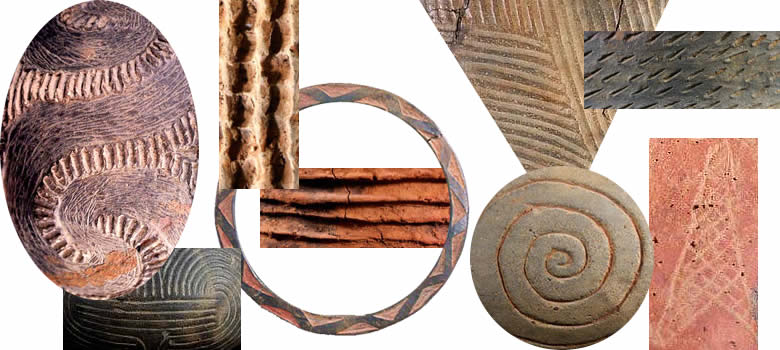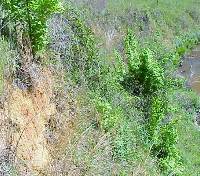
Good quality potters' clay can be gathered
from exposures along many creeks in the Caddo Homeland, like
Auburn Creek, a small spring-fed tributary of the Sabine River
in Smith County, Texas. Photograph by Mark Walters.
Click images to enlarge
|
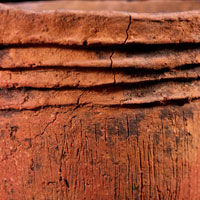
Neck banding and brushing. The last coils
of clay added to this jar were flattened and left distinct
to create a banded neck. Below the neck, the body of the jar
has been brushed to form a textured surface providing a sure
grip. Click on image to see enlarged view and the entire pot.
|
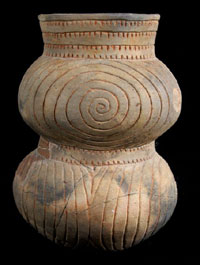
This unusual double-chambered jar obviously
was made by a master potter. The proportions and shapes are
perfect, the engraving superb. This beautiful pot must have
taken many hours to complete. Patton Engraved Jar, Historic
Caddo, after A.D. 1650. TARL collections. Click on image to
see enlarged view and detail of design.
|
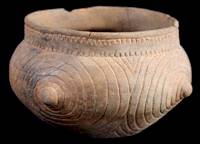
This inventive bowl has four teat-like
protruding nodes highlighted by engraved concentric circles
into which red ochre has been rubbed. This piece brings to
mind the observations made by early explorers describing geometric
tattoos they saw adorning the breasts of some Caddo women.
Note also the strong similarities with the double-chambered
jar—both pieces may be the work of a single master potter.
Patton Engraved bowl, Historic Caddo, after A.D. 1650. TARL
collections.
|
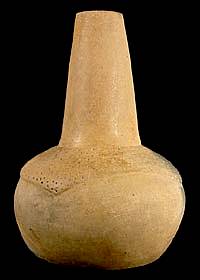
This untyped bottle has the unusual feature
of a punctated raised "mantle" on its shoulders.
This was probably added as second layer after the main bottle
was formed. Early Caddo ca. A.D. 900-1200/1300. TARL collections.
Click on image for enlarged view and for an alternate photo.
|
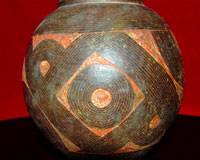
Detail of a tour de force example of incising
(fine lines) and incising (cut out area) by an Early Caddo
master potter. Holly Fine Engraved bottle from the George
C. Davis site. TARL collections. Photo by Sharon Mitchell.
|
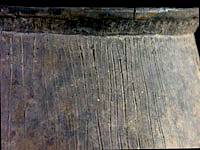
Detail of typical vertical brushing on
large Late Caddo jar. TARL Collections. Click to see enlarged
view and photo of complete vessel.
|
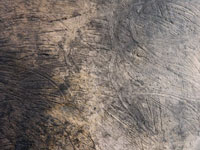
Detail of utility vessel with random brushing
patterns, an uncommon variation.
|
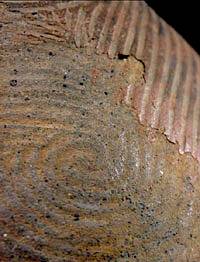
Detail of trailed bottle showing area where
slip has spalled off. Click for enlarged view, details, and
photo of entire vessel.
|
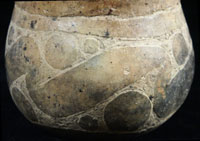
Detail of somewhat crudely done engraving
on an otherwise beautifully made jar. Click to see enlarged
view and photo of entire vessel.
|
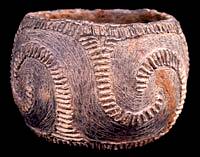
Powerful combination of incised raised
bands and brushing on this unusual vessel. Cowhide Stamped
bowl, Late Caddo, ca. 1400-1650. TARL collections.
|
|
Today pottery making thrives as a hobby, as an industry,
and as a form of artistic expression. Hundreds of books, films,
and websites exist that explain ceramic technology and pottery-making
techniques. But for those unfamiliar with the basic process and
those interested in the specific techniques favored by the ancient
and modern Caddo, here is a quick review.
The earthenware pottery made by the ancient Caddo
was made by hand using locally available materials and fired in
an open fire (as opposed to a kiln) at relatively low temperatures
(perhaps 600-700 degrees centigrade). Clay deposits suitable for
making pottery occur widely within the Caddo Homeland. In most areas
clay could be obtained easily from bluff exposures along rivers
and streams or by digging relatively shallow pits. Some clay deposits
are better suited for pottery making than others because they contain
fewer impurities or have useful properties such as the right degree
of plasticity (how easily wet clay can be shaped). Judging from
the copious quantities of Caddo pottery and from the high quality
of much of it, Caddo potters knew well where to find the proper
clays and how to prepare them.
Pure clay mixed with the right amount of water is
plastic (pliable) and can be easily formed into most any shape.
But most wet clays are so plastic that they won't hold a shape for
long before sagging and, as the clay dries, it tends to crack. A
further problem is that wet clay is very tacky and sticks to everything.
Like potters the world around, Caddo potters routinely solved these
problems by adding temper (non-plastic particles) to their clays
to help control the plasticity, to prevent drying cracks, and, in
some cases, to make their cooking pots withstand heat better. For
instance, relatively coarse temper was usually added to clays used
to make cooking vessels because the larger particles help the pots
take heat better than fine particles. The favored tempering agent
was grog (crushed potsherds). Burned and pulverized animal bone
was also used; burning is necessary in order to crush the bone properly.
After about A.D. 1300, burned and crushed mussel (freshwater clam)
shell was used as a temper by Caddo potters living along the Red
River and certain other areas. With practice, a potter learns just
how much of what kind of temper to add to create proper potter's
clay.
Once the clay mixture (paste) was ready, most Caddo
pottery was made using the coil method. First a flat disk was formed
that would serve as the base of the vessel. Rope-like fillets of
clay were then gradually coiled around the disk and mashed together
to form the vessel walls. The vessel walls were thinned, smoothed,
and compacted by the use of fingers, smooth river pebbles, shaped
sherds, or other tools. Redcorn uses dried gourds of various sizes
as anvils that she holds on the inside of a pot while she applies
a wooden scraper or wooden paddle on the outside to weld the coils
together, compact the clay, and form a smooth, even surface.
An experienced potter can make a simple bowl rather
quickly, in less than an hour. Large or complicated vessels take
many hours or even days to make because of the need to let the lower
parts partially dry before they are strong enough to add the upper
parts. When making larger pots with several different parts (like
long-necked bottles or vessels with tripod feet), Jereldine Redcorn
finds it best to "put it [the half-made pot] away for a few
days. When you come back to it, all of the sudden it is wonderful."
What she means is that curing the still-damp pot (she wraps hers
in a plastic bag) makes it easier to work with when adding on necks
and other elements. "The clay remembers," she says, and
holds its form. She suspects ancient Caddo potters did the same
thing, perhaps by wrapping their pots in wet animal skins. "You
can make some pots much quicker, by just keeping at it, but it's
hard to get wet clay to behave the way you want it to."
Finishing the form of the pot is only the first step.
Caddo potters seemed to have delighted in finishing and decorating
their pots in many different ways. While the pot was still damp,
the surface was sometimes textured by brushing (useful for making
water jars and cooking vessels less slippery) or by pinching it
to form ridges. Other favored decorative techniques at this stage
included the use of a thin, sharp tool (like a flint flake) to incise
narrow lines, pointed sticks to incise broader lines or create deep
punctations, fingernails to create curving impressions, and hollow
pieces of cane or reed to create small circles. Another technique
used in later prehistoric times involved the addition of small shaped
clay fillets (appliqué) or protruding "nodes" of
clay on the outside of the vessels to create raised relief.
Then the vessel was allowed to dry to what potters
call the green-ware stage. For the finer vessels, a second thin
layer of fine, untempered clay mixed with a red pigment called a
slip was sometimes added at this stage. The slip layer gave the
vessel a smooth, uniform appearance and sometimes a more desirable
color. Redcorn adds really fine clay slips to most of her pots to
enable her to create highly polished, mirror-like finishes that
those who buy her pottery seem to prefer. Ancient Caddo potters,
however, usually stopped well short of achieving highly polished
surfaces.
When the pot is completely dry (or almost so), the
green-ware vessel is burnished by wetting small areas of the outer
surface and rubbing the outside of the vessel with a small smooth
river pebble. This is a tedious and slow process, but one that results
in a vessel that has a lustrous appearance and a harder and less
porous exterior surface. Burnishing was usually done in parallel
strokes, up and down or side to side, leaving parallel burnishing
marks and a slightly uneven surface. If the potter was willing to
work hard enough and long enough, the burnishing marks could be
obliterated and the surface would become completely smooth and highly
polished.
Jereldine Redcorn found that learning how to properly
burnish a pot was one of her biggest challenges. Trials and errors
later, she now understands that burnishing must be done as a single
step without stopping. It takes her an hour to an hour and a half
to burnish a medium-sized bottle. She paints on small patches of
watery clay slurry and burnishes these quickly, adding one finished
patch to the next so she can make the burnishing look seamless.
Once the green-ware pot is completed and allowed to
thoroughly dry for several days, it is ready to fire. Ancient Caddo
pottery was apparently fired in an open bonfire, probably fueled
by wood and brush. Like most traditional potters, the Caddo women
probably fired more than one pot at a time. Whether the pots came
out with clear, bright, oxidized colors (red, yellow, light brown)
or dark, dull, reduced colors (gray, black) depended on how hot
the fire was and on the placement of the pots. (Clay type also factors
in to final color.) If the pots stayed hot after most of the fuel
had burned up, thus allowing air to reach the pots, they would become
oxidized. If the pots cooled while still covered by ash or up against
another pot, then they would have fire clouds and dark colors.
Redcorn likes to fire her pottery at a somewhat higher
temperature that her ancestors, in part because she usually uses
a higher quality commercial clay than her forebearers had access
to. She fires up to 15 pots at a time in a large metal barrel filled
with seasoned oak for intense heat and some fast-burning wood like
pine to get things going quickly. Her resident "wood expert,"
husband Charles Redcorn, gathers and prepares the wood. He also
helps her stack the pottery on different levels within the big barrel
to keep the pots from touching one another, to eliminate most fire
clouds. When she wants a black finish, she pours in a mix of sawdust
and powdered manure at the end of the firing to smother the fire
and create a reducing atmosphere.
After firing, ancient Caddo potters apparently engraved
some of their pots using a sharp flint tool like those used for
incising. Engraving leaves slightly rough-edged marks that cut through
rather than displace the outer layer of the pot through the slip
(if present). In contrast, incision and punctation displaces the
still-damp clay and leaves tiny ridges where the clay is pushed
up. The Caddo potters seem to have been very fond of incising and
engraving. They found many different ways to create pleasing decorative
effects by incising or engraving lines of different widths and depths,
adding tick marks, cross-hatching, parallel lines, curvilinear patterns,
and so on. To make the incised and engraved designs stand out, the
potters often rubbed mineral pigments, such as red ochre or white
kaolin clay, into the designs.
Jereldine Redcorn engraves her pottery after it is
polished and thoroughly dried, but before it is fired. Some archeologists
think the ancient Caddo did it that way too, although others hold
that engraving was done after firing. Perhaps it is mainly a question
of firing temperature and hardness. Vessels fired at higher temperatures
are just too hard to engrave, according to Redcorn. Becoming proficient
at engraving was the hardest thing she had to learn. She used bone
awls at first, but they kept wearing out and constantly needed resharpening.
Pieces of flint work, but are hard to hold on to. So today she usually
uses a metal awl. Part of the challenge of engraving is simply to
create nice even lines, particularly when they are closely-spaced.
She finds cross hatching to be "very tedious" and has
learned to take frequent breaks to let her hand rest.
But the real art of engraving lies in planning and
executing the design. For the first few years, Redcorn "tried
too hard." She wanted to make her designs perfectly symmetrical
and spent a lot of time trying to lay out each design (with a pencil)
before beginning engraving. With experience she has learned "to
just let things flow." She may trace out the major design elements,
but once she starts she does not try to make it perfect, "just
look good." Once she has used a design enough times, "it
becomes mine" and she no longer has to think so hard about
it. "I've learned to see the whole picture, the whole design,
and adapt it to fit each pot."
The photographs accompanying this exhibit illustrate
these and some of the other variations and techniques used by Caddo
potters of yesterday and today.
|
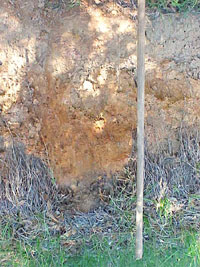
Closeup view of a clay bank along Auburn Creek, Smith County,
Texas. Impurities in some clays must be removed by hand or sieved
out before good pottery can be made. Photo by Mark Walters.
|
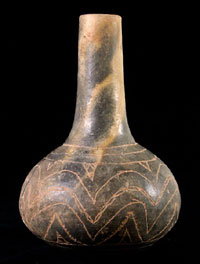
This untyped bottle is nicely formed, but
has rather poor quality engraving. The dark bottom and irregular
fire clouds on the neck suggest that it was fired in an upright
position. Middle to Late Caddo ca. A.D. 1200-1650. TARL collections.
|
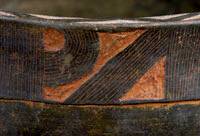
Detail showing combination of thin incised
lines executed while pot was still green; and incised areas
carved out after the pot was fired. Holly Fine Engraved bowl,
Early Caddo, ca. A.D. 900-1200. TARL collections. Click to
see enlarged view and photo of entire vessel.
|
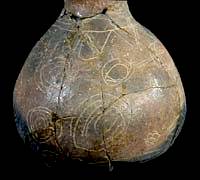
Bottle apparently engraved by a young potter
with a shaky hand. Antioch Engraved bottle, Middle Caddo,
ca. A.D. 1200-1400. TARL collections. Click to see enlarged
view and photo of entire vessel.
|
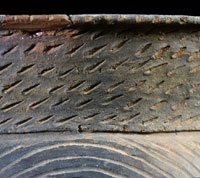
Detail of beautifully decorated jar. The
rim has been ticked, the neck has rows of diagonal punctations,
and the main body has spiraling incision. All these decorative
techniques were done before the vessel was fired. Foster Trailed
Incised jar, Historic Caddo, after 1650. TARL collections.
Click on image for enlarged view and photo of entire vessel.
|
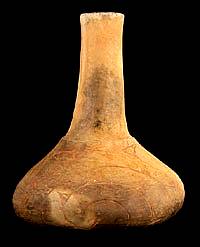
The flowing shape of this bottle suggests
the form of a squash or gourd. Unlike most bottles, the joint
between neck and body was made obvious by leaving it unsmoothed.
Perhaps the potter just liked the effect. Wilder Engraved
bottle, Late Caddo, ca. 1400-1650. TARL collections. Click
on image for enlarged view and detailed view of shoulder.
|
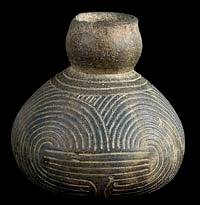
Magnificent example of near perfection
in decorative design and technique. Keno Trailed bottle, Historic
Caddo, after A.D. 1650. TARL collections. Click on image for
enlarged view and detailed shot of central design.
|
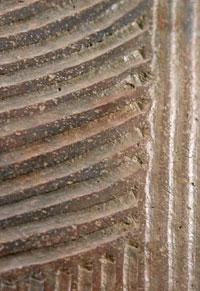
Detail of fine trailing (broad incised lines) showing how the
potter's tool displaced the still-wet clay. Click for enlarged
view, details and photo of entire vessel. |
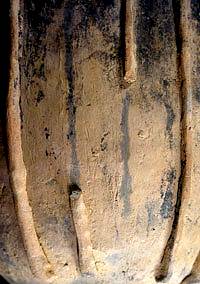
Detail of appliqué on Late Caddo jar. Click to see enlarged
view, details, and photo of entire vessel. |
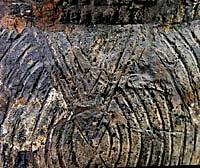
Detail of rather sloppy incising done while the clay was still
very wet. Click to see enlarged view, details, and photo of
entire vessel. |
|
